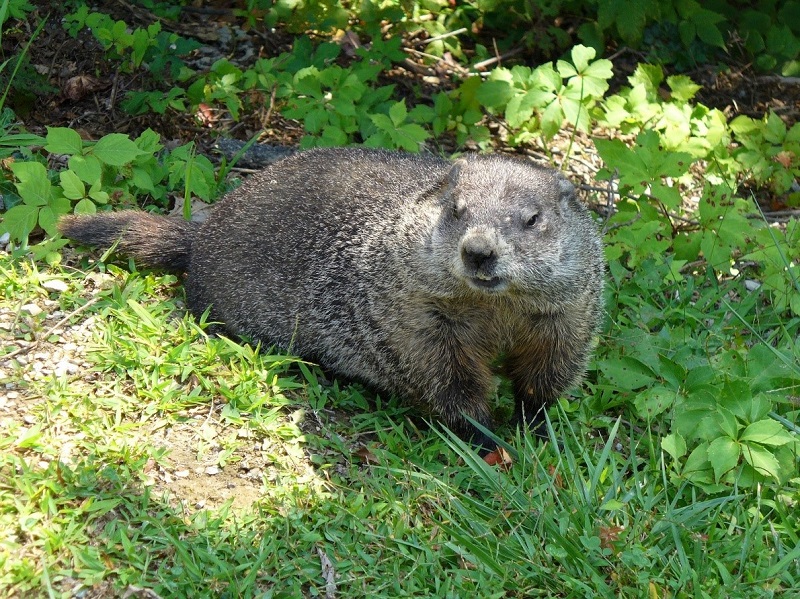How to Get Rid of Groundhogs

Spring is Here & So Are the Groundhogs — Also Known as Woodchucks
When winter comes to an end, spring breathes new life.
This includes wildlife — like groundhogs that dig burrows wherever they can raise their young, even if it’s on your property.
These rodents are seemingly innocent, but damage caused by groundhogs — also known as woodchucks — can be a big deal.
If you’re concerned that a groundhog has burrowed under a shed or other structure on your property, it’s important to understand how to prevent further damage. And of course, the best way to handle groundhog removal.
Ways to Prevent Damage Caused by Groundhogs to Your Yard
Whether you call them woodchucks or groundhogs, there’s one thing that’s certain: these critters like to spend a lot of time in their burrows and create underground tunnels.
In fact, these underground tunnels can cause damage to vegetation and have the potential to make structures unstable.
Sometimes a groundhog burrow can be obvious, like spotting a giant hole in the ground, while others are less obvious — like a hole under your shed or garage.
In some situations, handling a groundhog burrow on your own is possible. But, if you spot one of these critters or their young, professional groundhog removal is the best option to ensure safety for yourself and the animal(s).
Alter the Current Habitat
Make your yard or property less desirable to the critter. She
Groundhogs eat a variety of fruits and vegetables and can be found foraging gardens and farmlands looking for their next meal.
Nuts, foliage, and dandelions can also make a tasty meal for groundhogs.
Keep grassy areas trimmed, eliminate appetizing weeds or plants, and move wood piles to an enclosed structure.
These efforts will encourage the groundhog to move to another setting that offers more protection and a better food supply.

Interrupt Their Routine
While groundhogs spend most of their time hiding in the burrow and tunnels they’ve made, the critter does need to emerge for food and water.
Typically, groundhogs leave their burrow mid-morning to early-evening.
If they hear someone near the entrance of their burrow, it will discourage them from emerging. If this happens on a regular basis, the groundhog will be more likely to find a new area with less disturbances to build their home.
Unless you are a trained professional who knows how to handle nuisance wildlife, it is important to keep a safe distance from the burrow and the groundhog (if you spot one). Some animals could become defensive if they feel threatened.
Repel Them
Like other nuisance wildlife, groundhogs will avoid smells they don’t enjoy.
Spreading crushed garlic, cayenne pepper, or lavender around your garden won’t offend your senses, but it will make the groundhog(s) second guess looking there for a snack.
Soiled kitty litter can also act as a deterrent. While it’s less pleasant to work with than other items, it can be an effective method. Leaving some around a burrow entry, or near a wooded area on your property will act as a warning sign for groundhogs.
Groundhog & Woodchuck Removal & Exclusion
To truly protect your landscape, sheds, garages and other structures groundhog removal and exclusion is the best course of action.
Installing a fence around your property can help but isn’t necessarily the perfect solution. As we know, groundhogs dig tunnels, so the fence would have to be deep underground.
It isn’t as common, but groundhogs can also climb. So, if they are trying to get away from a predator, or survey the area, the could try to climb over your fence.
Professional groundhog removal and exclusion will be the easiest way to prevent damage caused by groundhogs.
As part of Catseye Pest Control’s Cat-Guard Exclusion system, Trench-Guard Wildlife Barrier ensures low-clearance areas, such as decks and sheds, are protected from wildlife.
Using underground trenching and a rigid permanent barrier, groundhogs, skunks, rats and other nuisance wildlife are prevented from causing damage and making a home where they aren’t wanted.
To learn more and to protect your property from groundhogs and other nuisance wildlife, contact our wildlife control professionals today.






